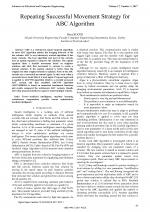| 3/2017 - 11 |
Repeating Successful Movement Strategy for ABC AlgorithmKOCER, B. |
| Extra paper information in |
| Click to see author's profile in |
| Download PDF |
Author keywords
artificial intelligence, machine learning, evolutionary computation, particle swarm optimization, machine intelligence
References keywords
optimization(18), algorithm(18), artificial(13), colony(12), comput(8), jasoc(6), swarm(5), soft(5), search(5), jins(5)
Blue keywords are present in both the references section and the paper title.
About this article
Date of Publication: 2017-08-31
Volume 17, Issue 3, Year 2017, On page(s): 85 - 94
ISSN: 1582-7445, e-ISSN: 1844-7600
Digital Object Identifier: 10.4316/AECE.2017.03011
Web of Science Accession Number: 000410369500011
SCOPUS ID: 85028548845
Abstract
ABC is a well-known nature inspired algorithm. In short ABC algorithm mimics the foraging behavior of the bee colonies. ABC is very intensively worked algorithm. It has many variants. The base algorithm and most of the variants uses an update equation to improve the solutions. The update equation finds a feasible movement based on neighbor solutions and adds that movement to current to create a mutant solution. If the mutant solution is better than the original one then original solution is updated. None of the ABC variant use a successful movement again. In this work when a successful move found then it is used again. Proposed approach is applied to ABCVSS algorithm which is a recently proposed ABC variant and that modified ABCVSS algorithm (ABCVSSRSM) is tested on numerical benchmark functions and results compared the well-known ABC variants. Results show that proposed method is superior under multiple criteria. |
| References | | | Cited By |
Web of Science® Times Cited: 1 [View]
View record in Web of Science® [View]
View Related Records® [View]
Updated 2 weeks, 4 days ago
SCOPUS® Times Cited: 1
View record in SCOPUS® [Free preview]
View citations in SCOPUS® [Free preview]
[1] Task scheduling using artificial bee foraging optimization for load balancing in cloud data centers, Muthsamy, Geetha, Ravi Chandran, Suganthe, Computer Applications in Engineering Education, ISSN 1061-3773, Issue 4, Volume 28, 2020.
Digital Object Identifier: 10.1002/cae.22236 [CrossRef]
Disclaimer: All information displayed above was retrieved by using remote connections to respective databases. For the best user experience, we update all data by using background processes, and use caches in order to reduce the load on the servers we retrieve the information from. As we have no control on the availability of the database servers and sometimes the Internet connectivity may be affected, we do not guarantee the information is correct or complete. For the most accurate data, please always consult the database sites directly. Some external links require authentication or an institutional subscription.
Web of Science® is a registered trademark of Clarivate Analytics, Scopus® is a registered trademark of Elsevier B.V., other product names, company names, brand names, trademarks and logos are the property of their respective owners.
Faculty of Electrical Engineering and Computer Science
Stefan cel Mare University of Suceava, Romania
All rights reserved: Advances in Electrical and Computer Engineering is a registered trademark of the Stefan cel Mare University of Suceava. No part of this publication may be reproduced, stored in a retrieval system, photocopied, recorded or archived, without the written permission from the Editor. When authors submit their papers for publication, they agree that the copyright for their article be transferred to the Faculty of Electrical Engineering and Computer Science, Stefan cel Mare University of Suceava, Romania, if and only if the articles are accepted for publication. The copyright covers the exclusive rights to reproduce and distribute the article, including reprints and translations.
Permission for other use: The copyright owner's consent does not extend to copying for general distribution, for promotion, for creating new works, or for resale. Specific written permission must be obtained from the Editor for such copying. Direct linking to files hosted on this website is strictly prohibited.
Disclaimer: Whilst every effort is made by the publishers and editorial board to see that no inaccurate or misleading data, opinions or statements appear in this journal, they wish to make it clear that all information and opinions formulated in the articles, as well as linguistic accuracy, are the sole responsibility of the author.



